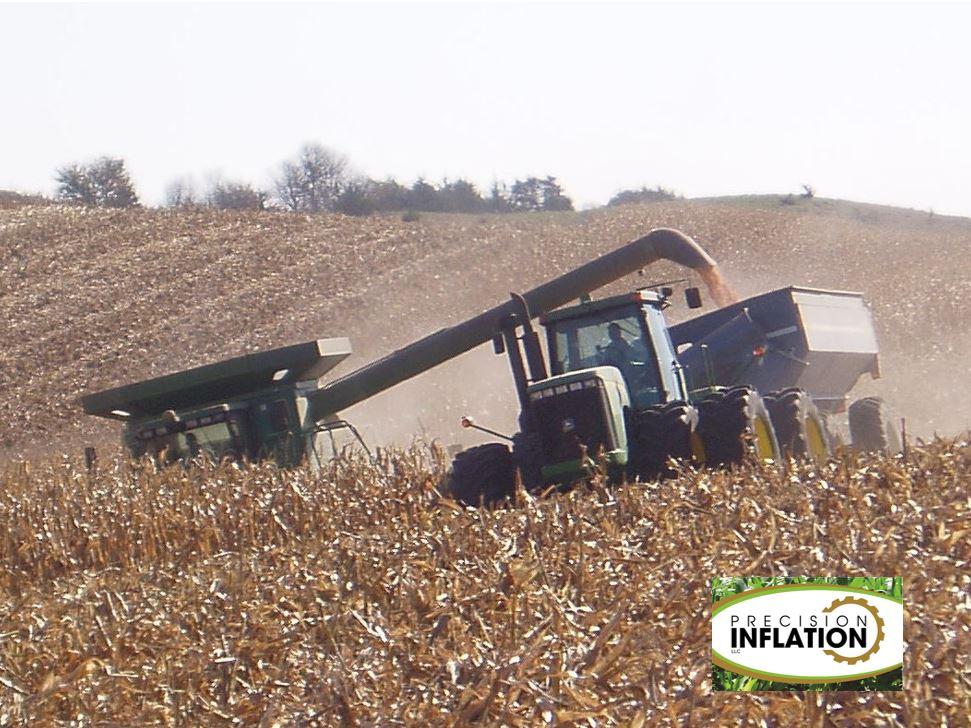AG Tire Talk Takeaways
MICHELIN: First, let’s understand why choosing the right tire at the correct pressure, as it relates to +20% grade, is important. Tires with inadequate inflation could potentially allow the lateral force to roll a tire right off the rim.
MAXAM: The three primary reasons to increase cold inflation air pressure when in sidehill or hillside operations:
1. Improved tire seating on wheel – provides stronger bead seating pressure against the flange of the wheel (seating pressure).
2. Increased air reduces sidewall flexing as weight transfer occurs as the tires work up or down / or travel laterally across a hillside (weight transfer).
3. Ensure vertical footprint pressure pushing tread band onto the operating surface (traction)
CONTINENTAL: TRA and its European counterpart ETRTO define a clear borderline at an 11° slope (20% grade). Is it black and white? I would rather take it as a clear orientation point from which more caution needs to be paid towards the topic.

PRECISION INFLATION: For +20% grades, most farmers should seriously consider a hillside combine option that levels the machine for better threshing and machine stability. For grades up to 20%, although Tire & Rim Association doesn’t mandate, I recommend raising tire pressures+ 6 psi above tire manufacturers’ load/inflation table minimum to provide additional tire protection- checking with Tire Dealer to make sure it’s within maximum allowable limits.
BKT: If radial tires are used with recommended air pressures for normal farming, they provide low lateral stability on the hillside. Air pressures must be adjusted up to take out some of the sidewall flex to keep the tire from rolling off the wheel on the steep slope. Increased air pressures also help with stability and prevent rollovers on steep slopes.
TRELLEBORG: When the application surpasses the 11-degree slope mark, the tires suffer a lot of sidewall stress that could damage the tires, create unstable lateral movement and be the cause of potential tire/rim unseating. To prevent this situation, several steps must be considered. Increase the recommended inflation pressure for normal conditions by 0.5 bar (7 psi)- the inflation pressure can be increased up to +25% without surpassing the maximum nominal inflation pressure of the tire. No load bonus below 20 mph (30 km/h) on non CHO/CFO tires. Cyclic bonus does not apply on CHO/CFO type tires.
YOKOHAMA: Tread pattern is also important on hillsides…the hybrid tread doesn’t dig into the ground on hillsides like R-1 lugs do, so they experience less slip and better efficiency and fuel economy.
GALILEO CUPWHEEL: Due to the unique design of our Galileo CupWheel tire, there is no need to increase the air pressure because lateral stability is maintained and even improved at low pressure – through the structure of the tire body, rather than air pressure. This gives us a huge advantage over conventional tires. At this point of Galileo CupWheel Tire development, I do not recommend use on more than 20% grade.
TITAN: Each steep slope application is different and could be potentially dangerous- I recommend contacting our engineering department.
AG TIRE TALK: Below illustrates an 11° (20% Grade):
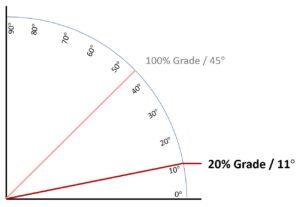
Maxam Tire International
Greg W. Gilland: Business Development & Ag Segment Manager
Each of our radial tires is designed to operate on the road or in the field based on the speed and load or weight being carried. The “cold” inflation air pressure or air pressure management is the key to optimizing how the tire will perform in any equipment, speed, load, or surface application. Sidehill or hillside applications require some adjustments to the cold inflation air pressure to allow radial tires to deliver the optimal performance because of the exceptional additional physical forces working on the tire. The three primary reasons to increase cold inflation air pressure when in sidehill or hillside operations are as follows:
- Improved tire seating on wheel – provides stronger bead seating pressure against the flange of the wheel (seating pressure)
- Increased air reduces sidewall flexing as weight transfer occurs as the tires work up or down / or travel laterally across a hillside (weight transfer)
- Ensure vertical footprint pressure pushing tread band onto the operating surface (traction)
The challenge for any farmer or grower is recognizing the impact of his operation’s hillside or sidehill grade level and what offsets he needs to consider in the effective and safe performance of his equipment.
The engineering or math to understand the how the grade or slope impacts a tire is provided below:

- Tangent of Slope Angle or Grade = Vertical Rise / Horizontal Distance.
- Percent Grade % = 100 x Tangent of Slope Angle.
- Examples:
- 15° Slope is a 26.8% grade
- 20° Slope is a 36.4% grade.
- 30° Slope is a 57.7% grade.
The impact of the grade % and/or “steepness” of the angle has to be accounted for to ensure that the tire’s cold inflation air pressure is adjusted to meet the additional forces (seating pressure, weight transfer/traction) when operate safely on any hillside or sidehill operation.
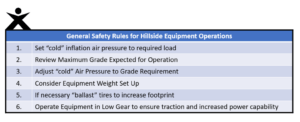
The below table and safety rules illustrate MAXAM’s recommended additional air pressure considerations required to operate either standard or VF tires on any agricultural equipment based on the grade % or slope/steepness of the operation:
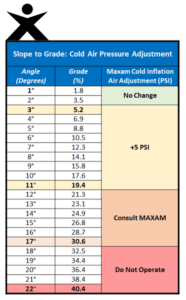
-
-
- Up to 20% grade increase cold air pressure by +5 PSI versus normal cold inflation operating air pressure
- Above 20% grade up to 30% grade please consult MAXAM for necessary Cold Air Pressure Adjustments
- It is recommended not to operate equipment above +30% grade due to safety concerns relating to equipment stability and risk of roll-over.
Using the right air pressure on any field or hillside operation will ensure you can achieve maximum utilization of your tires!
-
For technical questions, please contact:
MAXAM TIRE NORTH AMERICA
Tel: +1 844-629-2662
Email: marketing@maxamtirena.com
Michelin Ag
David Graden: Operational Market Manager – Agriculture
Regardless of slope, I would always lean towards recommending radial tires to maximize machine performance and minimize downtime. That being said, there is a rule of thumb Michelin uses and publishes in our data book, as a recommendation for +20% grade.
First, let’s understand why choosing the right tire at the correct pressure, as it relates to +20% grade, is important. I think it goes without saying, tires are directly responsible for transfer of torque, traction, flotation, and especially stability in this case. Additionally, tires with inadequate inflation could potentially allow the lateral force to roll a tire right off the rim. This would cost down time and possibly a very hazardous situation.
With regard to air pressures and making pressure recommendations, we typically assume an average of up to 12% weight shift across axles. Simply put, we take the weight of an axle and divide it across all tires +12% to account for this potential increase in load per tire, as it moves over varying terrain.
When a producer operates in a field(s) with slopes at +20% grade or more, safety and stability become a concern. If tires are not properly inflated, they may not be able to withstand the added weight and lateral stability and become compromised. For a +20% grade, your machine weight will transfer about 30% to one side. For this reason, we publish a standard recommendation of +6psi. As the slope gets more severe and the weight shift reaches 35% to 45%, we highly recommend consultation with the tire manufacturer for air pressure recommendations and corrections. Further, these recommendations may not exceed maximum allowable pressures, which if exceeded, may require another solution.
In summary, it is vitally important to know and check your air pressures frequently. If your machine will operate on +20% slopes or greater, this is even more important. If you need help with your Michelin tire pressure recommendations, please reach out to your local Michelin representative. Michelin reps regularly carry a set of scales and are equipped with the knowledge to recommend proper air pressures, optimum weight distribution for maximum torque transfer and problem solve any issues you may encounter.

For technical questions, please contact:
MICHELIN NORTH AMERICA
https://agricultural.michelinman.com/us/Contact-us
Continental Agriculture North America
Harm-Hendrik Lange: Customer Solutions Engineer for Continental Commercial Specialty Tires (CST)
Normally the recommendation for agricultural tires is to lower the inflation pressure as much as possible for the lowest soil compaction, the widest footprints and to have as many lugs as possible in contact with the ground for best traction. But to use the load-speed-inflation-pressure-matrix of a tire to the borderline values, tires should not be operated on steep inclines.
A logical question from the operator is, what is a steep incline?
TRA and its European counterpart ETRTO define a clear borderline at an 11° slope (20% grade). Is it black and white? I would rather take it as a clear orientation point from which more caution needs to be paid towards the topic. In the end, all our decisions should consider the border conditions of the operation- just as you would not ask how sharp a curve can be, before you need to brake, to proceed safely in your car.

Imagine a self-propelled sprayer with a quite high center of gravity (red dot) on an incline. The sprayer has an adjustable tire track width R&P axles. If you look at the pictures, you would agree, that the example on the left is close to tip over. This means, nearly 100% of the vertical load of the vehicle has shifted to the lower tire. This of course needs to be considered in the load capacity of the tire as well as the required additional inflation pressure inside the tire, that now carries nearly twice as much as normal! This is still not enough! As this lower tire has due to the higher load also higher traction, this tire additively needs to withstand almost all of the side forces, resulting in a big side deformation of the carcass.
In contrast to the above, the situation and driving stability improves substantially in the picture on the right. The tire track width is adjusted to the maximum position. Of course, the lower tire has a much higher load compared to the upper one, but maybe only ~75%. So 25% of the vertical load, but also ~25% of the side (steering) force can be handled by the upper tire – this unburdens the lower tire a lot compared to the example on the left.
So you agree that´s quite logical that the wider tire track width is the safer version, but in this article, the focus is not on the track width, but on the tire situation. We can use this extreme example to better understand, that the border conditions can change a lot, along with required inflation pressures for tires in incline applications. If required, fill up the tire to nominal max inflation pressure.
Combines have quite high grain storage. If the full capacity of the grain tank needs to be used, this can have very strong effect on the driving stability on steep inclines, but in the same way to the de-loading of the uphill tire and the additional load of the downhill tire with the resulting higher side (steering) forces on the higher laden tire. You can imagine that a 15% load bonus for CHO or CFO tires is quickly eaten up on steep inclines and cannot be taken into account like in level conditions. Ask yourself if you can de-load the grain tank more often on steeper inclines.
If the operator asks for the effects of different tire types on inclines… The good old bias tire has a higher sidewall stiffness compared to a radial-type-carcass, which may help him to better handle the strong side forces. If we compare a “normal” radial tire with IF and VF tires, here the same logic applies: the more flexible the sidewall, the more it will deform on slopes as a reaction to the side forces. But with identical load and same inflation pressure, the standard tire, IF tire and VF tire may have a comparable resulting deformation, if not using the additional 20% load of IF or 40% additional load of VF.
Agricultural tire manufacturers are clearly listing up to 20% incline within their data books for the practical application of load – pressure tables. If the slope operation exceeds this value, it is advised for the customer to contact the tire manufacturer. In any case, an air pressure increase is desirable, providing more rigidity on the sidewall area and increasing the load capacity of the tire; however, there is no correlation between the slope and the air pressure increase, which makes it more difficult to choose a value.
For technical questions, please contact:
CONTINENTAL NORTH AMERICA
Dana Berger, AG Sales Manager, U.S.
Dana.Berger@conti-na.com
Precision Inflation, LLC
Ken Brodbeck, VP of Technology
SIDEHILL +11° Slope (+20% Grade) Tire Adjustments
Adjust Tire Pressure As Necessary
Whether you farm along terraces or go up and down hilly fields, your tires will see higher vertical and lateral loads than on flat fields.
Traction and flotation also can be critical in wet hilly conditions.
What should you do?
Combines / Tractors:
- For +20% grades, most farmers should seriously consider a hillside combine option that levels the machine for better threshing and machine stability.
- For grades up to 20%, although Tire & Rim Association doesn’t mandate, I recommend raising tire pressures+ 6 psi above tire manufacturers’ load/inflation table minimum to provide additional tire protection- checking with Tire Dealer to make sure it is within maximum allowable limits.
- For +20% grades, I recommend calling the tire manufacturer.
- Increasing pressure for all grades will reduce lateral sway and improve stability.
- Choosing optional larger tire size will increase load capacity.
What should you do if you have both flat AND hilly fields?
Adjust pressures depending on the field condition.
Without an “On the Go Inflation System” you are going to be stuck at one pressure because NO ONE changes 8 tires by hand from field to field.
Precision Inflation, LLC specializes in systems that allow you to adjust your tire pressures to the conditions you need:
- Changing axle loads with front fold planters
- Changing from pull type to fully mounted implements
- High speed transport for manure and spraying operations to low-speed field work.
- Simply being able to check and adjust your tires every day to keep them at their optimum field and road pressure provides a huge return on investments
Remember, Pressure Matters!
BKT USA, Inc.
Dave Paulk: Manager Field Technical Services
There are differing opinions on using bias tires or radial tires in hillside applications. Some think that the higher air pressures and increased sidewall stiffness of bias tires provide better hillside stability. Others think that radials provide better traction. In either case, tires used in this application must provide both stability and traction, and air pressure must increase to accommodate.
Caution should be used on sloped areas. Hillside applications can change the center of gravity of the tractor or combine, especially with loads. Loads (loaded hoppers on combines) increase weight on the downward side and makes the machine top heavy. Increased air pressures can offset some of the weight shifts and minimize tire sidewall separations.
The point at which air pressures and hillside stability become crucial seems to be the 11-degree slope (20% grade). The TRA Handbook lists load carrying capacities and speeds up to this point before referring to manufacturer’s recommendations. There are some TRA load and inflation charts that include hillside combine applications, but load adjustments and increases below 20 mph do not apply.
Radials are becoming more prevalent in hillside applications on tractors and combines. Radial tires by design have a flatter and larger footprint than bias tires and provide good lateral traction. The IF/VF design provides an even larger footprint than standard radials or bias tires. If radial tires are used with recommended air pressures for normal farming, they provide low lateral stability on the hillside. Air pressures must be adjusted up to take out some of the sidewall flex to keep the tire from rolling off the wheel on the steep slope. Increased air pressures also help with stability and prevent rollovers on steep slopes. It is generally recommended to add 6 psi over the recommended air pressures for tractors on hillsides operating on 20% Grade, keeping all within maximum air pressure allowance. The steeper the hill side, the more air that needs to be added to compensate for the sidewall flex- and that is when you should call BKT for air pressure recommendations.
For technical questions, please contact:
BKT USA Inc.
Dave Paulk, Manager Field Technical Services
(330) 836-1090
Trelleborg Wheel Systems
Norberto Herbener: OE Applications Engineer
When the application surpasses the 11-degree slope mark, the tires suffer a lot of sidewall stress that could damage the tires, create unstable lateral movement and be the cause of potential tire/rim unseating. To prevent this situation, several steps must be considered:
- Increase the recommended inflation pressure for normal conditions by 0.5 bar (7 psi). The inflation pressure can be increased up to +25% without surpassing the maximum nominal inflation pressure of the tire.
- No load bonus below 20 mph (30 km/h) on non CHO/CFO tires.
- Cyclic bonus does not apply on CHO/CFO type tires.
Operations such as small orchards and vineyards where a large footprint and lateral stability are keys – Trelleborg has recently launched a new series of tires. The PneuTrac series of tires is a perfect match for these high demanding operations. These tires combine the flexibility and adaptation advantages of a rubber tire with the lateral stability and larger footprint of a track. These tires can be mounted on traditional rims.
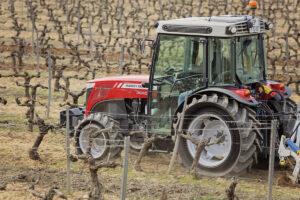
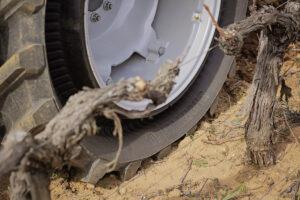
The innovative «Omega» design helps the tire provide many benefits. It helps the casing sustain load and provides flexibility. The tire can run at very low pressure resulting in very low soil compaction.
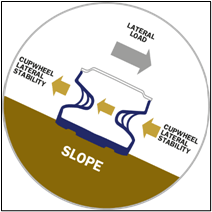
PneuTrac tires also utilize Trelleborg’s exclusive interlug terraces which provide excellent self-cleaning. The tire has Trelleborg’s patented ProgressiveTraction® technology which incorporates a dual edge lug for additional traction and grip – and reduces the “brush” effect of the lugs during work – for additional stability and durability.

Looking into the future the Pneutrac series will be expanded to include tire sizes fitted for other operations and conditions.
For additional questions on correct and efficient tire usage and performance on sidehill conditions, contact your trusted tire dealer.
Galileo CupWheel
Dr. Lucy Edery-Azulay, R&D Manager
Working on an incline or slope condition causes an uneven distribution of the load on the tires. One of the tires will be caring a significantly larger portion of the loaded in proportion to the slope angle.
In order to compensate for this in conventional tires, one increases the air pressure. Increasing the air pressure makes it possible to maintain some lateral stability. Due to the unique design of our Galileo CupWheel tire, there is no need to increase the air pressure because lateral stability is maintained and even improved at low pressure – through the structure of the tire body, rather than air pressure. This gives us a huge advantage over conventional tires.

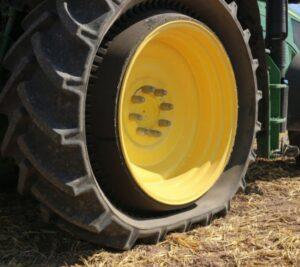
At this point of Galileo CupWheel Tire development, I do not recommend use on more than 20% grade.
Yokohama Off-Highway Tires America
Nick Phillippi: National Product Manager
Inflation pressure is especially important for farmers operating on steep slopes because of the extreme stress on the bead area and the need for stability. Too little air can allow the bead to roll off the rim. Too much air prevents the tire from absorbing impact and transfer those shocks to the rest of the machine. If there was ever an application for central tire inflation systems (CTIS) for on-the-go adjustments in inflation pressure, this is it.
It’s important to remember that since putting a machine on a steep angle puts more of its weight on the downhill tires, so the usual load inflation tables don’t apply—you’ll need to add 5 to 7 psi over the stated no-slope inflation pressure on slopes of 20% Grade, making sure not to exceed maximum allowable pressures, and call your tire dealer or manufacturer if you are operating on slopes over 20 percent.
Tread pattern is also important on hillsides. We’ve seen a huge response to what we call our “hybrid” tread on the Alliance 550, which is a directional block tread design. In the Palouse wheat country, where combines operate on 40, 50 or even 60-degree slopes, Hillco—a company that builds and installs self-leveling packages for combines—started mounting Alliance 550s in 2015 and by 2017, that’s all their customers wanted.
Their original goal for the switch away from R-1s and R-3s to the 550 was to get better lateral stability from the block tread, which worked beautifully. But what they also found is that the steel radial construction created a nice, flat contact patch that not only reduced lateral slip, but improved forward traction. Farmers have also told us that the hybrid tread doesn’t dig into the ground on hillsides like R-1 lugs do, so they experience less slip and better efficiency and fuel economy.
I believe the long, flat footprint backed by the steel belts of the 550—or any of Alliance’s high-horsepower, steel-belted radials—spread the load more evenly between the tread and the sidewalls, while more conventional tires push the force up the sidewall toward the bead.
When it comes to steep slopes, the tire itself has to be really well-built, including a very strong bead bundle and a sturdy sidewall turn-up, to take the added load and stress. And the rim has to be extremely strong, too, especially with a tire that is going to reduce slip and put all that engine torque into the wheel. Every piece of the system has to be up to the challenge.
For technical questions, please contact:
YOKOHAMA OFF-HIGHWAY TIRES AMERICA
Nick Phillippi, National Product Manager—Agriculture
(339) 900-8119
Titan International, Inc. (Manufacturer of Titan and Goodyear Farm Tires)
Scott Sloan: Ag Product Manager / Global LSW
Each steep slope application is different and could be potentially dangerous- I recommend contacting our engineering department so we can review and discuss your specific situation. Once we determine what the proper set up is, we can deploy one of our Ag Specialists to the unit and ensure it is set up correctly.
For technical questions, please contact:
TITAN INTERNATIONAL, INC.
corp.marketing@titan-intl.com
217-221-4313
TECHNICAL ASSISTANCE CONTACT LIST
MICHELIN NORTH AMERICA
https://agricultural.michelinman.com/us/Contact-us
MAXAM TIRE NORTH AMERICA
Tel: +1 844-629-2662
Email: marketing@maxamtirena.com
CONTINENTAL NORTH AMERICA
Dana Berger, AG Sales Manager, U.S.
Dana.Berger@conti-na.com
BKT USA INC.
Dave Paulk, Manager Field Technical Services
(330) 836-1090
YOKOHAMA OFF-HIGHWAY TIRES AMERICA
Nick Phillippi, National Product Manager—Agriculture
(339) 900-8119
FIRESTONE
FirestoneAg.com
TITAN INTERNATIONAL, INC. (Manufacturer of Titan and Goodyear Farm Tires)
corp.marketing@titan-intl.com
217-221-4313
All information is provided in this blog solely to provoke thought. All deductions made from information on this site must be confirmed by Certified Ag Tire Dealer and tire manufacturer where specified before use. Ag Tire Talk does not recommend anyone conduct tire service work with exception of Certified Ag Tire Dealer Professionals.

